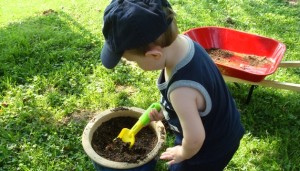“What’s best for the environment?” is often asked these days. Well, what’s best for the environment is teaching our children respect and concern for nature. One way to start this training early, and have some fun doing it, is a child’s garden. The immediate and long-term benefits of encouraging a child to plant his or her own garden are enormous.
Through school and the media, many youngsters, even preschoolers, are already very aware of nature and ecology. The garden is an excellent place to reinforce what they have heard and learned and a great place to encourage their creativity and self-discipline. They will be exposed to the beauty of Nature, a beauty they will help nurture, and through growing vegetables they may learn a degree of self-sufficiency. A childhood start on understanding and respecting the environment plants the “seeds” for future responsibilities. We all know it needs to be done, so let’s do it with fun.
Lions and Dragons
Did you ever “snap” the jaws of a snapdragon, or “see” fantastic faces in pansies, or savor the tangy aroma of fresh mint when you crushed some leaves in your hands when you were a child? Whether you did or you didn’t, there are numerous plants that provide their own extra-special sense of fun and learning. Below are a few suggestions. Maybe you have some childhood memories to add.
Some “Fun” Plants to Grow
Calceolaria – called the “”pocketbook” plant, the blooms resemble old-fashioned purses.
Four O-Clocks – Easy to grow from seed, these colorful flowers don’t open until mid-to late afternoon.
Torenia – The “wishbone plant.” Inside the bloom is a small ridge shaped just like a wishbone.
Lunaria – The ‘money plant’ forms disc shaped seedpods that can be easily rubbed and polished to resemble a silvery quarter sized coin.
Scallop Squash – Summer squashes that resemble flying saucers
Impatiens – “Bizzy Lizzy” or “Impatient” plant. The ripe seedpods burst open to scatter seed. Put a fat one in your hand and press lightly for a good tickle when it bursts.
Sweet Peas – Dwarf or climbing, these lovely flowers have the same name as the character in Popeye cartoons. Maybe you should plant it next to the spinach.
Starter Suggestions
A small garden, perhaps no more than 4 feet by 4 feet and planted with a mix of flowers and vegetables, can instill not only an appreciation of Nature, but also provide a place for fun learning activities. Although there is a chance that a child’s garden might not be as neatly tended as a parent’s, give the choicest garden spot you can to the child. Lots of sun and good soil will aid in success. A section of your garden or a separate child’s garden next to yours can make the garden chores a family affair.
Let your child help prepare the garden soil. Dirt can be turned over with a small shovel or trowel, and clumps broken up by hand or by “stomping” on them. Kids love dirt!
Choose easy-to-grow plants and as many different ones as you can get into the small space. Carrots, radishes, lettuces and tomatoes are good vegetable choices. If you have room for the vines, maybe a giant Jack O ‘Lantern or a mini-pumpkin can make the garden experience last a little longer.

Leave a Reply
You must be logged in to post a comment.